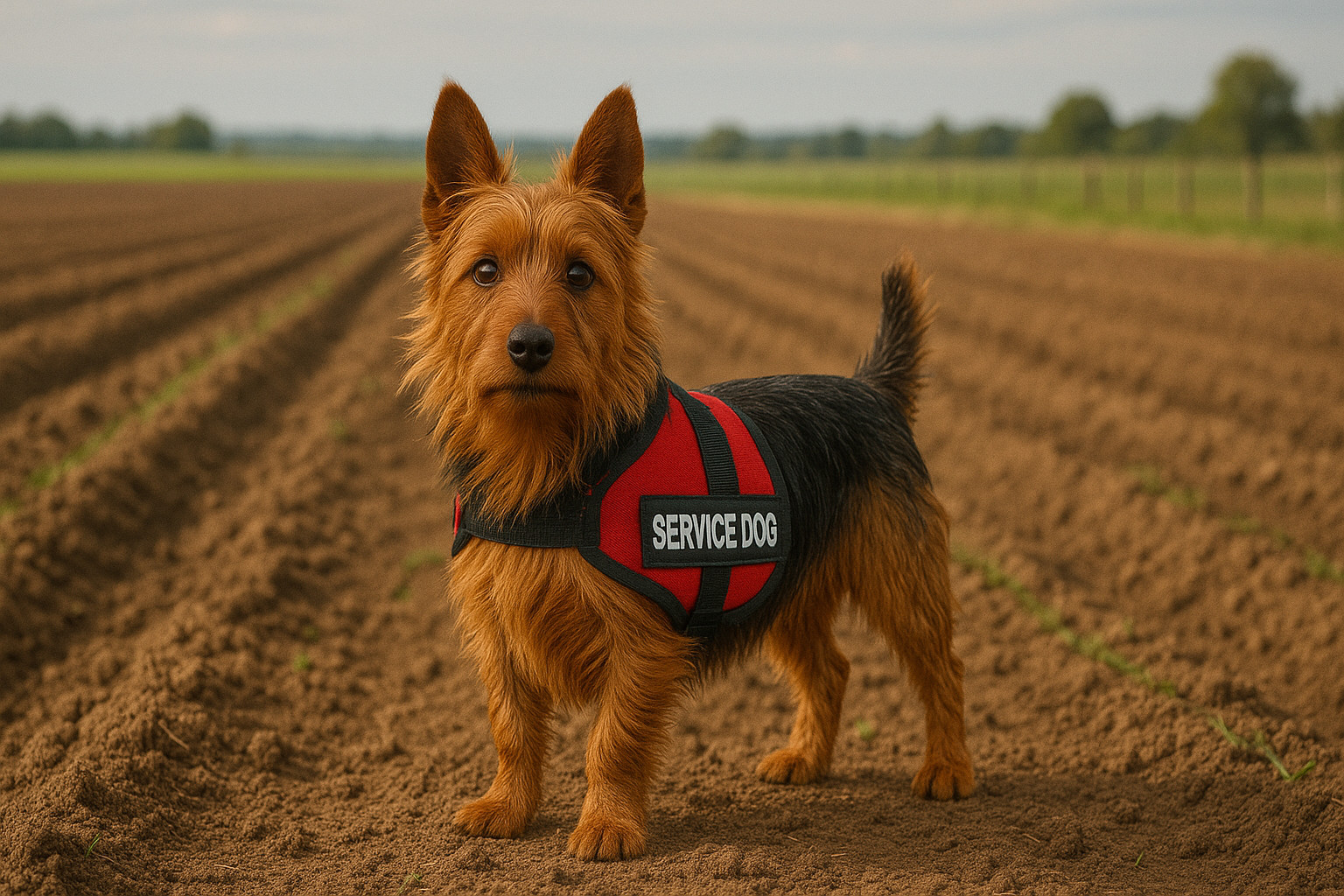Australian Terrier as a Service Dog

The Australian Terrier, known for its spirited and tenacious nature, makes a compelling candidate for certain types of service work. Although not a common choice compared to larger breeds like Labrador Retrievers or Golden Retrievers, the Australian Terrier brings unique qualities that can be incredibly beneficial in specific service dog roles.
Australian Terrier Overview
The Australian Terrier traces its origins back to the 19th century in Australia. Initially, this breed was developed to control vermin and snakes, showcasing their resilience and hunting prowess. Their adaptable nature and hardiness, traits typical of companion dogs, make them a versatile addition to the service dog community, especially when their specific attributes align with the needs of the handler.
Physical Characteristics
The Australian Terrier is a small, yet robust breed. Their average height ranges from 9 to 11 inches, and they typically weigh between 14 to 16 pounds. Despite their small stature, they possess a sturdy frame and a well-proportioned build.
- Size: Compact and easy to transport, especially suitable for handlers requiring a dog that does not exceed size constraints in public or private spaces.
- Coat: They have a harsh, weather-resistant outer coat that is dirt-repellent, reducing maintenance in varied conditions. The dense undercoat offers additional protection.
- Eyes and Ears: Their eyes are dark brown and have a keen, intelligent expression. Erect ears exhibit alertness, an asset for individuals needing a dog capable of notice auditory cues.
Their size makes them unsuitable for tasks requiring substantial strength, like mobility assistance, but their compactness is ideal for those who need a manageable dog.
Temperament and Attitude
Australian Terriers are known for their inquisitive, outgoing, and energetic nature. They exhibit a blend of courage and tenacity, married to a friendly and loyal disposition. These temperamental qualities play a substantial role in their suitability for specific service roles:
- Alertness: Their history as working terriers manifests in a heightened state of awareness, making them excellent at providing medical alerts, such as detecting low blood sugar in diabetic handlers.
- Affectionate Nature: Australian Terriers are naturally devoted, forming strong bonds with their handlers. This loyalty fosters a conducive environment for emotional support and psychiatric service needs.
- Independence: While they can exhibit a streak of stubbornness, their independence means they can be left to self-regulate in environments where consistent human oversight isn't possible.
However, their independent spirit also brings challenges. They require consistent training to curb their natural instinct to chase and explore, traits innate to their terrier lineage.
Types of Service Work
Given their size and temperament, Australian Terriers excel in certain roles over others. Their primary strengths lie in:
- Medical Alert Services: Their acute sense of smell and alert nature make them adept at medical alerts, particularly in detecting changes related to blood sugar levels, seizures, or allergies.
- Psychiatric Support: Their unwavering bond with handlers and keen sense of environment contribute to their effectiveness in mitigating anxiety and providing comfort.
- Emotional Support: While not legally recognized as service dogs in all contexts, their devoted nature and size make them excellent when a calming presence is needed.
However, due to their size, they are not typically suitable for roles involving physical guidance or mobility support, where larger breeds are generally more effective.
Health Considerations
Every dog breed has potential health considerations that could impact service work, and the Australian Terrier is no exception. Key considerations include:
- Hip Dysplasia: Despite their small size, Australian Terriers can suffer from joint issues, which can affect their longevity in service roles.
- Luxating Patella: A common issue in smaller breeds, it involves the dislocation of the kneecap, posing challenges in maintaining long-term activity levels needed for service work.
- Allergies: This breed can be prone to skin allergies, necessitating regular grooming and monitoring.
- Diabetes: Genetically predisposed, this condition requires regular monitoring, which could affect their service work capability if not managed properly.
Health maintenance through regular veterinary checks, diet, and exercise is crucial to ensure the longevity and effectiveness of Australian Terriers in service roles.
Training and Suitability
Australian Terriers are noted for their intelligence, which bodes well for training. However, their terrier independence introduces unique challenges:
- Intelligence and Learning: They are quick learners, able to remember commands and perform complex tasks. This makes them well-suited for roles requiring cognitive problem-solving.
- Challenges in Training: Their independent and sometimes stubborn nature means that training needs to be consistent, with strong leadership to reinforce commands and deter undesirable behaviors.
- Socialization Needs: From a young age, Australian Terriers require extensive socialization to ensure they are comfortable in various environments. Socialization is critical for service dogs due to their exposure to different stimuli.
Positive reinforcement techniques work best, rewarding them for consistent behavior. Their mental acuity means they thrive on tasks that challenge their intellect and provide a sense of purpose.
Summary of Australian Terrier
While not traditionally considered for service roles, the Australian Terrier offers distinct advantages where their specific attributes can shine:
- Strengths:
- High alertness and sensitivity, suitable for medical alerts.
- Affectionate nature, helpful in psychiatric and emotional support roles.
- Compact size offers ease of transport and minimal spatial demands.
- Weaknesses:
- Not suitable for mobility support due to size limitations.
- Health issues like joint problems may require maintenance and consideration.
- Independent temperament requires experienced and consistent training.
- Ideal Service Roles:
- Medical alert detection (diabetes, seizures)
- Psychiatric support for anxiety or PTSD.
- Emotional support for those needing a companion for mental well-being.
In conclusion, the Australian Terrier represents a blend of compact agility and perceptive alertness, making them highly effective in specialized service roles. Tailoring the training and environments to align with their unique capabilities can yield a rewarding partnership between handler and dog.











